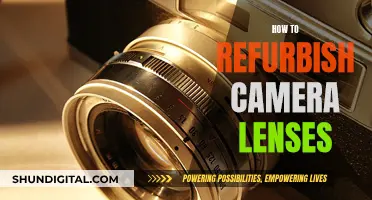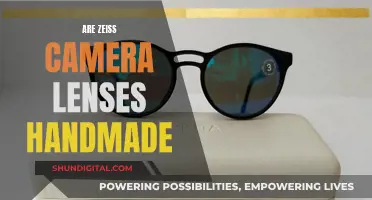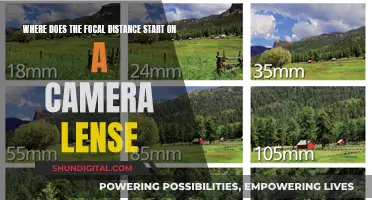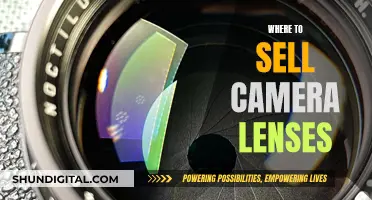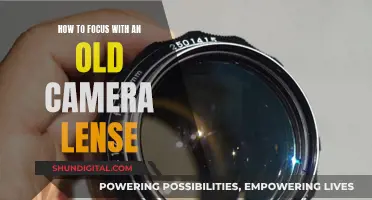
When it comes to camera lenses, it's a common misconception that expensive lenses are the only way to achieve exceptional image quality. While it's true that high-end lenses can offer superior performance and features, cheaper lenses can still produce fantastic images without breaking the bank. In fact, some of the best cheap lenses on the market offer great value for money, providing creative versatility and impressive results.
When considering cheaper lenses, it's important to be mindful of the trade-offs. Cheap lenses may not rival expensive ones in terms of optical quality, but they can still deliver effective performance. Additionally, they tend to be more lightweight, making them ideal for travel and reducing the heartache if they are lost or damaged. It's also worth noting that cheap lenses often have a reputation for feeling plasticky compared to the rugged metal build of their expensive counterparts.
So, which camera companies offer cheaper lenses? Canon, Nikon, and Sony are well-known for their affordable 50mm f/1.8 lenses, which are usually priced at $200 or less and compatible with both full-frame and crop sensor cameras. Canon also offers a range of inexpensive pancake lenses, known for their compact size and convenience. Olympus and Panasonic are other brands worth considering for cheaper lenses, and for those seeking a more unique option, SLR Magic's 26mm f/1.4 Toy lens offers a distinctive toy camera look.
In conclusion, while cheap lenses may not offer the same level of optical quality as their expensive counterparts, they can still be a great choice for photographers on a budget or those looking for a lightweight and convenient option. By doing some research and reading reviews, it's possible to find hidden gems that offer excellent value and creative possibilities.
| Characteristics | Values |
|---|---|
| Camera company with the cheapest lenses | Canon |
| Best cheap lenses | Canon EF-S 24mm f/2.8 STM, Canon EF 50mm f/1.8 STM, Nikon AF-S 50mm f/1.8G, Fujifilm XC 35mm f/2, Olympus 9mm f/8 Fisheye Body Cap |
What You'll Learn

Canon lenses are priced well for what you get
One of the most popular Canon lenses is the "thrifty fifty," or the Canon EF 50mm f/1.8 STM lens. This lens is a great everyday option, performing well in low light and creating beautiful blurred backgrounds. It is also very affordable, usually costing around $200 or less, making it a great choice for beginners and experienced photographers alike.
Another great option for Canon users is the Canon RF 50mm f/1.8 STM lens, which is designed for full-frame mirrorless cameras. This lens is lightweight, compact, and versatile, making it perfect for everyday shooting, portraits, landscapes, and more. It also features a control ring that allows for easy adjustments to aperture, shutter speed, ISO, and other settings.
In addition to these 50mm options, Canon also offers a range of affordable wide-angle, zoom, and prime lenses. For example, the Canon EF-S 24mm f/2.8 STM "pancake" lens is a super-thin and lightweight option, perfect for travel and everyday shooting. The Canon EF-S 10-18mm f/4.5-5.6 IS STM lens is another affordable wide-angle option, ideal for shooting in tight spaces or capturing vast landscapes.
For those looking to upgrade their kit lens, the Tamron 18-200mm F/3.5-6.3 Di II VC lens is a versatile and economical choice, offering a broad focal range and image stabilization for steady shots.
Overall, while Canon lenses may not be the cheapest on the market, the quality and features they offer make them a great value for photographers of all levels.
Samy's Camera: Renting Lenses and Photography Equipment
You may want to see also

Nikon has the cheapest lenses on the used market
If you're looking for cheap lenses, Nikon has hundreds of popular options available on the used market. You can find a Nikon lens for your camera without having to spend thousands of dollars.
Nikon's AF-S 50mm f/1.8G lens is a great option for those on a budget. It offers good performance for the price, and is handy for portraits on DX models. The bokeh highlights are not quite circular, but the sharpness and contrast are impressive even when shooting wide-open at f/1.8.
Another option is the Nikon AF-S DX 35mm f/1.8G lens, which is an ultra-compact standard prime lens for APS-C Nikon DSLRs. It has a solid build for the money, with a metal mounting plate and ring-type ultrasonic autofocus. While the corner sharpness is not great, it is still a compact and lightweight lens that is well worth the asking price.
In addition to these options, there are also older Nikon prime lenses that use a modern mounting system, such as the Canon EF 100mm f/2 USM and the Canon EF 85mm f/1.8 USM. These lenses can still deliver great image quality and can often be found for less than $350 new, and even less on the used market.
When buying used lenses, it is important to consider the condition and compatibility of the lens with your camera. It is also worth noting that cheap lenses may not have the same build quality, low light capabilities, or sharpness as more expensive lenses. However, they can still be a great option for those on a budget or those who want to try out different lenses without spending a fortune.
Choosing Camera Lenses: A Guide to Perfect Photography
You may want to see also

Sony's APS-C range is expensive
Sony's APS-C range is considered expensive compared to other camera companies. Canon and Nikon, for instance, are known for their cheaper lenses.
While Sony's APS-C range is expensive, it is also extensive and offers a wide variety of lenses to choose from. The range is a favourite of travel photographers and is highly regarded for its compact body, powerful features, and excellent AI autofocus recognition and tracking.
However, when compared to other camera brands, Sony's APS-C lenses are generally more costly. For example, Canon offers cheaper alternatives with its EF-S and EF ranges, which include popular options like the Canon EF-S 24mm f/2.8 STM and the Canon EF 50mm f/1.8 STM. Nikon also has affordable lenses, such as the Nikon AF-S 50mm f/1.8G and the Nikon AF-S DX 35mm f/1.8G.
Additionally, other camera brands like Fujifilm and Panasonic also offer cheaper lenses. Fujifilm's Fujinon XC35mm F2 lens is a budget-friendly option, and Panasonic's Lumix G85 camera is known for its solid image stabilisation and good value.
In summary, while Sony's APS-C range offers impressive features, it comes at a higher cost when compared to other camera brands and their respective lens options.
Clean Your Phone Camera Lens Scratch-Free
You may want to see also

Fujifilm is quite expensive
When it comes to camera equipment, it seems that Fujifilm is quite expensive compared to its peers. For example, the cost of the Fuji X system is higher than that of similar setups from other brands. In one comparison, a Nikon Z6 with a 24-70 F/4 lens costs around €2000, while a similar setup in the Fuji X system, such as the X-T4 or X-H1 with a 16-55 F/2.8 lens, would cost between €2500 and €3000. This price difference becomes even more noticeable when considering that the Nikon Z6 can be paired with faster prime lenses that can achieve results that Fuji cameras cannot.
However, it is important to note that Fujifilm offers features that its competitors may not have. For example, the Fuji 16-80 F/4 lens has image stabilisation and weatherproofing, which the Nikon 24-70 F/4 does not. Additionally, in the United States, a Fuji X-T4 with a 18-55 F/2.8-4 lens is cheaper than the Nikon Z6 with the 24-70 F/4 lens.
Fujifilm also tends to offer more affordable options for high-end zoom lenses. For instance, the Fuji 16-55 F/2.8 lens is significantly cheaper than the equivalent full-frame lens from Nikon. Furthermore, some unique prime lenses are available for the Fuji X mount at a lower price than their full-frame counterparts.
While Fujifilm may offer certain advantages and competitive prices in specific areas, it falls short when it comes to telephoto lenses. The company offers a limited selection of zooms and fast, long primes, and users may need to resort to using adapters with lenses from other brands to meet their needs.
In summary, while Fujifilm provides some cost-effective options, particularly for standard zooms and unique prime lenses, it is generally more expensive for similar setups from other brands, especially when considering telephoto lenses.
Understanding Camera Focal Lengths: A Beginner's Guide
You may want to see also

Canon is the cheapest option for buying more lenses
Inexpensive 50mm f/1.8 lenses
Canon offers inexpensive 50mm f/1.8 lenses, such as the Canon EF 50mm f/1.8 STM, that are compatible with both full-frame and crop-sensor cameras. These lenses typically cost around $200 or less and are a great option for those starting in photography. They are versatile and can be used for everyday shooting, portraits, and low-light situations.
Pancake lenses
Canon also offers compact and inexpensive pancake lenses, such as the Canon EF-S 24mm f/2.8 STM and the Canon EF 40mm f/2.8 STM. These lenses are easy to store and carry, making them ideal for travel and street photography. They usually have a maximum aperture of f/2.8, which is decent for low-light situations.
Old prime lenses
Canon has a range of old prime lenses, such as the Canon EF 85mm f/1.8 USM, that use a modern mounting system and can be purchased for less than $350 new. These lenses offer great image quality and are a more affordable option than newer lenses.
Cheap wide-angle zoom lenses
Canon's cheap wide-angle zoom lenses, such as the EF-S 10–18mm f/4.5–5.6 IS STM, are a great deal for those who need an inexpensive wide-angle lens. These lenses are ideal for everyday shooting, architectural photography, and capturing scenes in tight spaces.
Affordable telephoto lenses
Canon offers affordable telephoto lenses, such as the Canon RF 100-400mm f/5.6-8 IS USM, that are perfect for capturing distant subjects like athletes or wildlife. These lenses provide excellent value for the price and are a great addition to any photographer's kit.
Compatibility of Pentax Lenses with Fujica Cameras
You may want to see also
Frequently asked questions
Some cheap camera lenses for beginners include the Canon EF-S 24mm f/2.8 STM, Canon EF 50mm f/1.8 STM, Nikon AF-S 50mm f/1.8G, and the Fujifilm XC 35mm f/2.
Canon, Nikon, and Sony are some camera brands that offer cheaper lenses.
When buying a cheap camera lens, it is important to consider the quality of the lens, the camera mount, and whether the lens is compatible with your camera model. It is also recommended to buy lenses that are native to your camera's mount or use an adapter produced by the camera company.
It is recommended to avoid third-party lenses, cheap zoom lenses, and knockoff lenses when buying a cheap camera lens.


